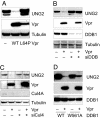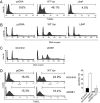HIV-1 Vpr function is mediated by interaction with the damage-specific DNA-binding protein DDB1
- PMID: 17360488
- PMCID: PMC1820720
- DOI: 10.1073/pnas.0610167104
HIV-1 Vpr function is mediated by interaction with the damage-specific DNA-binding protein DDB1
Abstract
The Vpr accessory protein of HIV-1 induces a response similar to that of DNA damage. In cells expressing Vpr, the DNA damage sensing kinase, ATR, is activated, resulting in G(2) arrest and apoptosis. In addition, Vpr causes rapid degradation of the uracil-DNA glycosylases UNG2 and SMUG1. Although several cellular proteins have been reported to bind to Vpr, the mechanism by which Vpr mediates its biological effects is unknown. Using tandem affinity purification and mass spectrometry, we identified a predominant cellular protein that binds to Vpr as the damage-specific DNA-binding protein 1 (DDB1). In addition to its role in the repair of damaged DNA, DDB1 is a component of an E3 ubiquitin ligase that degrades numerous cellular substrates. Interestingly, DDB1 is targeted by specific regulatory proteins of other viruses, including simian virus 5 and hepatitis B. We show that the interaction with DDB1 mediates Vpr-induced apoptosis and UNG2/SMUG1 degradation and impairs the repair of UV-damaged DNA, which could account for G(2) arrest and apoptosis. The interaction with DDB1 may explain several of the diverse biological functions of Vpr and suggests potential roles for Vpr in HIV-1 replication.
Conflict of interest statement
The authors declare no conflict of interest.
Figures





Similar articles
-
The DDB1-DCAF1-Vpr-UNG2 crystal structure reveals how HIV-1 Vpr steers human UNG2 toward destruction.Nat Struct Mol Biol. 2016 Oct;23(10):933-940. doi: 10.1038/nsmb.3284. Epub 2016 Aug 29. Nat Struct Mol Biol. 2016. PMID: 27571178 Free PMC article.
-
HIV-1 Vpr-mediated G2 arrest involves the DDB1-CUL4AVPRBP E3 ubiquitin ligase.PLoS Pathog. 2007 Jul;3(7):e85. doi: 10.1371/journal.ppat.0030085. PLoS Pathog. 2007. PMID: 17630831 Free PMC article.
-
HIV-1 Vpr loads uracil DNA glycosylase-2 onto DCAF1, a substrate recognition subunit of a cullin 4A-ring E3 ubiquitin ligase for proteasome-dependent degradation.J Biol Chem. 2010 Nov 26;285(48):37333-41. doi: 10.1074/jbc.M110.133181. Epub 2010 Sep 24. J Biol Chem. 2010. PMID: 20870715 Free PMC article.
-
The functions of the HIV1 protein Vpr and its action through the DCAF1.DDB1.Cullin4 ubiquitin ligase.Cytokine. 2010 Jul;51(1):1-9. doi: 10.1016/j.cyto.2010.02.018. Epub 2010 Mar 27. Cytokine. 2010. PMID: 20347598 Free PMC article. Review.
-
Partner molecules of accessory protein Vpr of the human immunodeficiency virus type 1.DNA Cell Biol. 2004 Apr;23(4):193-205. doi: 10.1089/104454904773819789. DNA Cell Biol. 2004. PMID: 15142377 Review.
Cited by
-
The human immunodeficiency virus type 1 Vpr protein and its carboxy-terminally truncated form induce apoptosis in tumor cells.Cancer Cell Int. 2009 Aug 12;9:20. doi: 10.1186/1475-2867-9-20. Cancer Cell Int. 2009. PMID: 19674438 Free PMC article.
-
Cellular restriction factors of feline immunodeficiency virus.Viruses. 2011 Oct;3(10):1986-2005. doi: 10.3390/v3101986. Epub 2011 Oct 21. Viruses. 2011. PMID: 22069525 Free PMC article. Review.
-
HIV-1 Vpr induces the degradation of ZIP and sZIP, adaptors of the NuRD chromatin remodeling complex, by hijacking DCAF1/VprBP.PLoS One. 2013 Oct 8;8(10):e77320. doi: 10.1371/journal.pone.0077320. eCollection 2013. PLoS One. 2013. PMID: 24116224 Free PMC article.
-
Cullin E3 ligases and their rewiring by viral factors.Biomolecules. 2014 Oct 13;4(4):897-930. doi: 10.3390/biom4040897. Biomolecules. 2014. PMID: 25314029 Free PMC article. Review.
-
DDB1 regulates the activation-induced apoptosis of T cells via downregulating the expression of histone methyltransferase SETD7.Med Oncol. 2023 Apr 12;40(5):146. doi: 10.1007/s12032-023-02015-8. Med Oncol. 2023. PMID: 37043057
References
-
- Sherman MP, De Noronha CM, Williams SA, Greene WC. DNA Cell Biol. 2002;21:679–688. - PubMed
-
- Muthumani K, Desai BM, Hwang DS, Choo AY, Laddy DJ, Thieu KP, Rao RG, Weiner DB. DNA Cell Biol. 2004;23:239–247. - PubMed
-
- Goh WC, Rogel ME, Kinsey CM, Michael SF, Fultz PN, Nowak MA, Hahn BH, Emerman M. Nat Med. 1998;4:65–71. - PubMed
Publication types
MeSH terms
Substances
Grants and funding
LinkOut - more resources
Full Text Sources
Other Literature Sources
Molecular Biology Databases
Research Materials
Miscellaneous

